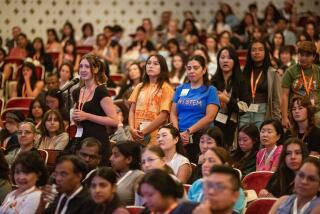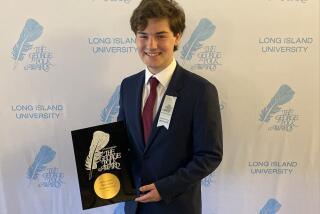Teamwork, Not Rivalry, Marks New Era in Research
Caltech professor Richard Andersen is pursuing a futuristic way to help people with paralyzed limbs.
He is trying to develop high-tech artificial body parts that would enable a patient to move, say, a mechanical arm simply by thinking about doing it. That daunting goal, however, has required expertise beyond Andersen’s neuroscience specialty.
So, when he launched the project in 1998, he brought in a campus robotics expert, Joel W. Burdick. As their work progressed, they added electrical engineers, a physicist and a neurosurgeon.
“I really can’t see how it would happen any other way,” Andersen said.
That kind of teamwork across departmental lines was once a rarity at the nation’s most prestigious universities. But the practice, usually known as interdisciplinary research, is spreading rapidly. The state’s leading research universities, including Stanford, USC and the University of California system, are among the pace-setters.
These campuses are turning adventurous scholars loose to pierce the barriers between fields of knowledge and to search for discoveries at the intersections of traditional academic disciplines.
They are teaming psychologists and anthropologists with economists, laboratory biologists with computer-modeling experts, and scientists who study the brain with humanities professors who explore music and art.
One of the main reasons for the surge in interdisciplinary research is the complexity of today’s crucial issues, including global climate change, terrorism and AIDS.
“For any problem that has some importance today, you find that, really, it doesn’t fit neatly into biology or into chemistry or into law. It tends to have many ramifications,” said Roberto Peccei, UCLA’s vice chancellor for research. “If you think of universities as trying to address problems, then it’s natural that they should be engaged in broad, multidisciplinary research.”
In part, the trend is being spurred by huge sums of federal money newly earmarked for interdisciplinary research. Also playing a big role are powerful computers and other high-tech tools that, as with Andersen’s project, have provided new ways of investigating long-standing questions and have created incentives for experts of differing backgrounds to partner up.
But only in recent years has the university world -- often slow to change because of entrenched bureaucracies and academic turf fights -- warmed to that idea.
Schools are freeing researchers to energize hybrid fields with offbeat names such as neuroeconomics, computational biology, geobiology, and brain-based humanities.
The trend has been especially dramatic in engineering and the sciences, particularly biology-related fields. David Baltimore, president of Caltech and a Nobel laureate biologist, said that in recent years, the successful mapping of the human genome -- itself a product of interdisciplinary research -- had fueled even more collaboration. He said scientists had to investigate thousands of genes and millions of interactions among them.
Yet, Baltimore said, “biologists are simply not trained in how to deal with questions on that scale of complexity. So we have to look to computer scientists, to mathematicians, to engineers of various sorts. We have to look to chemists and physicists to help us answer the many questions that we have at our fingertips right now.”
Andersen’s project -- which aims, essentially, to one day read paralyzed people’s minds about intended motions by tracking their brain signals -- reported major progress in July. His Caltech team succeeded in decoding the thoughts of three rhesus monkeys about their intended movements, using electrodes implanted in the animals’ brains.
Definitive figures for government spending on interdisciplinary projects remain scarce. But, according to a recent analysis by Rand Corp., federal funding for interdisciplinary research and development at U.S. universities climbed to $675 million in 2002, more than double the $330 million in 1997. Other analysts contend that the spending is higher.
In addition, the National Institutes of Health, the biggest federal patron of academic research, a year ago announced a “roadmap” for the future that stressed interdisciplinary initiatives. It budgeted $2.1 billion over five years for the effort.
Much of the work is taking place in new interdisciplinary units created to cut through customary academic rivalries. Stanford has been aggressive with such initiatives as the Global Climate and Energy Project, the Bio-X program focusing on research in biology and medicine, and the newly announced Institute for the Environment.
UC, with $400 million pledged by the state in 2000, is developing four California Institutes for Science and Innovation. One of the interdisciplinary institutes, based at UCLA and UC Santa Barbara, is working on nanotechnology, which involves devices the size of atoms or molecules that might improve computers or treat disease.
One of USC’s efforts, the Institute for Creative Technologies, has brought together its engineering, cinema-television and communication schools, along with Hollywood and the video game industry, to develop virtual-reality technologies.
Nationally, a sign of the changing times came in October 2002, when Princeton psychologist Daniel Kahneman won the Nobel Prize in economics for his work in the hybrid field of behavioral economics.
Still, some experts say, the quality of some interdisciplinary research is questionable. In certain cases in the humanities and social sciences, “interdisciplinary work simply provides a home for misfits, malcontents, those who are anti-disciplines without being pro-anything,” said Howard Gardner, a Harvard Graduate School of Education professor studying interdisciplinary trends.
He expressed skepticism about the quality of scholarship in “soft” fields lacking assessment standards, which he said included such areas as women’s studies, Latino studies and media studies.
This is hardly the first time in history that leading thinkers have crossed from one field of learning into another. Polymath scholars in ancient Greece, the Middle Ages and the Renaissance all made a huge mark in the advancement of knowledge.
In the 20th century, interdisciplinary research flourished in the private sector and government laboratories. World War II’s Manhattan Project is a leading example. But major universities, which enjoyed a research boom after the war, increasingly became entrenched along disciplinary lines.
As a result, interdisciplinary research at universities remains “a risky route for young researchers to take,” said Veronica Boix Mansilla, a Harvard researcher working with Gardner.
Some leading young researchers cross disciplinary boundaries anyway. Columbia University’s Duncan Watts, 33, is an associate professor of sociology, but he uses analytical techniques he learned while a student in physics, engineering and math.
Watts said that when he initially tried to publish his PhD dissertation, which blended math and sociology, a prospective editor asked for assessments from an academic reviewer in each field.
The result? “Well, the mathematician said, ‘This isn’t mathematics,’ and the sociologist said, ‘This isn’t sociology.’ So it was promptly rejected,” he said.
Eventually, the project was published as a book. Even so, Watts says he and other interdisciplinary researchers often face similar objections.
His research team at Columbia is probably known best for a massive e-mail project evaluating the popular notion that just “six degrees of separation” link people around the world. (An initial phase found that there typically were seven steps between any two people located in different countries.)
A big attraction of interdisciplinary projects, Watts said, is that “a lot of the standard problems kind of got beaten to death.”
Today, he said, “you have young, ambitious people looking around for other ways to parse the world in order to do something original.”
More to Read
Sign up for Essential California
The most important California stories and recommendations in your inbox every morning.
You may occasionally receive promotional content from the Los Angeles Times.










